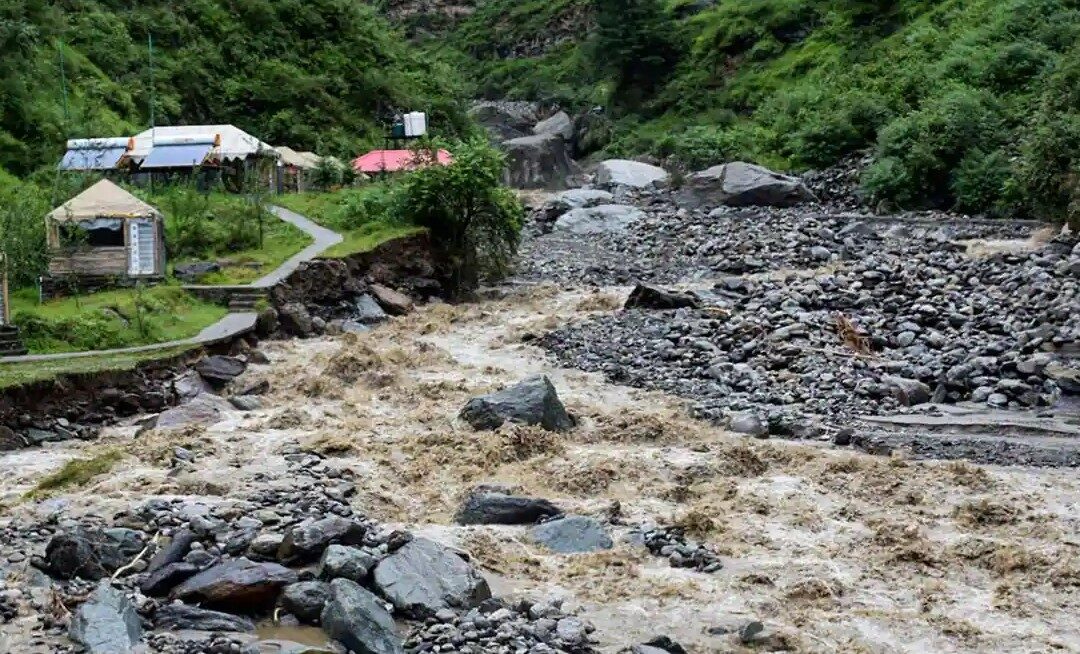The entire Himalayan belt is increasingly vulnerable to cloudbursts, flash floods, landslides, and potential glacial lake outburst floods (GLOFs), all driven by changing monsoon patterns and accelerated warming in the region. These risks are not only
becoming more frequent but are also spreading across a wider geographic areas

Sudhish Ramteke,Associate Director, Anand Rathi Insurance Brokers
So far this year, India has witnessed a series of devastating cloudburst-induced flash floods across the Himalayan states, resulting in severe loss of life and large-scale destruction of property and infrastructure.
The worst-affected was Kishtwar (J&K), where a cloudburst in Chositi claimed over 67 lives, left more than 200 missing, and injured more than 300 people. Himachal Pradesh experienced multiple cloudburst and flash flood events during June–July,causing 92 deaths, several missing, and economic losses estimated at nearly ₹2,700 crores.
In Uttarkashi (Uttarakhand), a flash flood on 5 August killed at least 7 people, left more than 50 missing, and destroyed homes and farmland.
These recurring disasters highlight the rising vulnerability of Himalayan states to extreme rainfall, cloudbursts, and glacial lake outburst floods (GLOFs),
emphasizing the urgent need for resilient infrastructure, effective early warning
systems, and stronger disaster risk management.
Over the past decade, such events have claimed more than 700 lives across the Himalayan belt. The 2013 Kedarnath disaster remains a stark reminder of how cloudbursts, combined with blocked river channels and fragile infrastructure, can trigger catastrophic floods and landslides.
Today, with the Himalayas warming faster than the global average, accelerated glacier melt and shifts in snow and monsoon patterns are increasing peak flows and elevating the risk of GLOFs, making the region one of the most climate-sensitive in the world.
Emerging Risks to watch out for in future
-Glacial Lake Outburst Floods (GLOFs) as glaciers retreat and lakes grow/instability increases.
-Debris flows and blockage-created dam breaches – landslide debris can temporarily dam rivers; such breaches can lead to sudden downstream floods.
-Exposure growth & unplanned development of roads, hydropower, tourism infrastructure increases vulnerability. Also development on fragile slopes or in river corridors magnifies impacts.
Practical Risk Management solutions / actions
For state/local government and communities:
-Hazard mapping & land-use zoning — The authorities can update landslide,
floodplain and GLOF-hazard maps and restrict the future development accordingly.
-Early warning systems & real-time monitoring — rain gauges, stream gauges,
glacier/lake monitoring and community warning chains reduce casualties.
-Slope stabilization & natural measures — reforestation, check-walls –
Retaining Walls, Gabion Walls, Soil Nailing, Rockfall Barriers, improved
drainage and engineered slope anchors for critical road and settlement areas.
-Evacuation routes & resilient lifeline infrastructure — design roads/bridges to
avoid single-point failures, create safe evacuation shelters.
What Insurance & financial protection tools policy makers in India can use
-Property Insurance covers — A Government funded first loss insurance cover upto ₹ 1 Lac value can be introduced for insuring all the Dwellings & Personal Properties of the local public. This should be designed in such a way so as to provide immediate relief to the effected public after any major disasters.
-Parametric Cover (index based insurance) — pays a pre-agreed amount when a trigger (e.g., rainfall intensity at a station, upstream river gauge, or Earthquake seismic reading) is met. This insurance cover ensure faster payouts, useful for emergency cash needs and post-disaster liquidity. India is actively piloting parametric solutions for different hazards and public schemes.Few Indian states have already designed similar policies.
-Catastrophe risk pools — Through this mechanism multiple entities can share the financial burden of large scale disasters. This involves pooling resourcesthrough insurance or other financial instruments to cover losses arising out of Catastrophic events such as Earthquakes, hurricanes, floods, cloud burst etc.Some proposals in India consider using disaster funds to buy parametric covers.
-Micro-insurance & local community schemes — Immediate payouts to households (linked to early relief) reduce hardship; can be paired with local community preparedness grants.
-State risk pool / reinsurance: aggregate premiums for multiple districts and
buy reinsurance to protect public finances.
The entire Himalayan belt is increasingly vulnerable to cloudbursts, flash floods,
landslides, and potential glacial lake outburst floods (GLOFs), all driven by changing
monsoon patterns and accelerated warming in the region. These risks are not only
becoming more frequent but are also spreading across a wider geographic area.
According to World Bank estimates, landslide risk in Uttarakhand could rise
dramatically—by up to 90% in certain areas by 2050 under warming scenarios.
Addressing these threats requires a blended strategy: stronger land-use planning
and resilient engineering, real-time monitoring and early warning systems, and
innovative risk transfer mechanisms such as indemnity and parametric insurance,
supplemented by public risk pools for faster relief.
On a national scale, the World Resources Institute highlights that India has the
world’s highest GDP exposure to river flooding—about USD 14.3 billion (₹1,22,980
crore), a figure that could increase tenfold by 2030 as the economy grows. India
already faces average annual flood losses of around USD 7.5 billion (₹64,500 crore).
Extreme rainfall events, intensified by rising temperatures and shifts in monsoon patterns, are worsening the flood situation. Unplanned urban expansion and
environmental degradation further amplify the damage, displacing millions of people
and causing widespread destruction.
India faces one of the world’s widest protection gaps for natural disasters, with more
than 90% of economic losses uninsured. While disasters such as floods, cyclones, and
landslides cause billions of dollars in damages annually, only a small fraction is
covered by insurance.
Swiss Re’s analysis highlights India’s severe natural disaster protection gap, with
nearly 93% of losses remaining uninsured. Over 2013–2022, India suffered average
annual economic losses of about US$ 8 billion from floods, cyclones, and other
catastrophes, yet only a small fraction was covered by insurance.
In recent years, Swiss Re has emphasized that India continues to experience multi-
billion-dollar losses each year, but limited penetration of catastrophe and property
insurance means households, businesses, and the government absorb most of the
financial burden. This underscores both the rising exposure to climate-driven
disasters and the urgent need to expand risk transfer solutions in the country.
Meanwhile, Munich Re data reinforce the global trend: many regions especially the
Asia Pacific region continues to see well below 5% of natural disaster losses insured.
Together, these findings spotlight India’s growing climate risk exposure and the
urgent need to scale up affordable insurance and other risk-transfer mechanisms to
shield households, businesses, and public infrastructure from the increasing financial
burden of the natural disasters.

